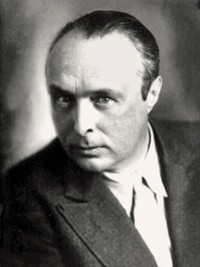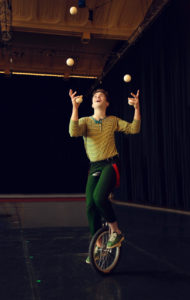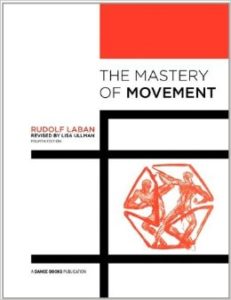 Laban’s life work was to create a rich palette of movement options from which a performer could draw. By the time he wrote Mastery of Movement, he had a lifetime of experience observing movement and working with dancers and actors, which he distilled into this intriguing work.
Laban’s life work was to create a rich palette of movement options from which a performer could draw. By the time he wrote Mastery of Movement, he had a lifetime of experience observing movement and working with dancers and actors, which he distilled into this intriguing work.
Ironically, Laban’s own creative methods and experimental dance and theatre works are little known. However, recent re-creations of work mounted by Valerie Preston-Dunlop, Alison Curtis-Jones, and Melanie Clarke provide glimpses of his work and methods that are useful in illuminating aspects of Mastery of Movement.
In particular, re-creations based upon repertoire of the Kammertanzbühne Laban reveal Laban’s theatrical vision. Housed in an exhibition hall at the Hamburg Zoo, this small company performed several times each week for subscribers who came again and again in the mid-1920s. As Preston-Dunlop notes, the company concentrated on four types of dance: “ornamental, ecstatic, grotesque” and national folk dances. The grotesque, “covered dances that were dramatic, odd, funny and made people uncomfortable, curious, amused, flabbergasted,” in other words, more theatrical than the other three types, which were respectively attractive, solemn, and colorful.
Laban and his assistant, Dussia Bereska, choreographed works, as did members of the company. Much of the movement material was improvised, then shaped, as Preston-Dunlop notes, “through bodily, choreutic, and eukinetic articulation.” As Laban notes in his autobiography, “familiar characters came into being, who were welcomed by the audience as old acquaintances just as in the medieval theatre.”
“For example,” Laban continues, there were “the jester, the juggler, obstinancy, rage, playfulness, the dandy, the tyrant, death, and many more.” Some of these characters make repeat performances in the many dramatic scenarios Laban provides to stimulate readers’ movement imaginations.
Give your own dramatic imagination some food for thought in the forthcoming correspondence course, “Mastering Rudolf Laban’s Mastery of Movement.”

 I have been re-reading Laban’s autobiography in preparation for teaching
I have been re-reading Laban’s autobiography in preparation for teaching  Mastery of Movement is for body and effort what Choreutics is for space and shape – the most comprehensive treatment of Laban’s ideas in English. The book has an interesting history.
Mastery of Movement is for body and effort what Choreutics is for space and shape – the most comprehensive treatment of Laban’s ideas in English. The book has an interesting history. Laban wrote Mastery of Movement on the Stage (1st edition) “as an incentive to personal mobility.” And indeed, the first two chapters provide a number of explorations organized around movement themes focused on body and/or effort. Laban hopes to encourage a kind of “mobile reading,” as he explains in the Preface.
Laban wrote Mastery of Movement on the Stage (1st edition) “as an incentive to personal mobility.” And indeed, the first two chapters provide a number of explorations organized around movement themes focused on body and/or effort. Laban hopes to encourage a kind of “mobile reading,” as he explains in the Preface. Long before diversity became a political issue, Warren Lamb was encouraging diversity in management teams. His model of diversity was not based on age, race, creed, or gender. Rather it was based on decision-making style.
Long before diversity became a political issue, Warren Lamb was encouraging diversity in management teams. His model of diversity was not based on age, race, creed, or gender. Rather it was based on decision-making style. In his observation and analysis of thousands of business executives,
In his observation and analysis of thousands of business executives,  Shortly after I completed my Laban Movement Analysis training (1976), Warren Lamb gave a short course at the Dance Notation Bureau. I had been thinking a lot about the relationship between movement and psychology, but in vague and hypothetical ways. What Lamb presented was much more concrete — it blew me away.
Shortly after I completed my Laban Movement Analysis training (1976), Warren Lamb gave a short course at the Dance Notation Bureau. I had been thinking a lot about the relationship between movement and psychology, but in vague and hypothetical ways. What Lamb presented was much more concrete — it blew me away. In 2011, I participated in a pilot study examining the validity of Movement Pattern Analysis profiles in predicting decision-making patterns. Although MPA has been used by senior business teams for over 50 years, its potential application to the study of military and political leaders has barely been tapped. The pilot study was the first test of this new area of application.
In 2011, I participated in a pilot study examining the validity of Movement Pattern Analysis profiles in predicting decision-making patterns. Although MPA has been used by senior business teams for over 50 years, its potential application to the study of military and political leaders has barely been tapped. The pilot study was the first test of this new area of application. The application of Movement Pattern Analysis in building teams was not the focus of my experiment with making basic profiles of undergraduate dance majors for a seminar on career development. However, I realized that an implicit team relationship clearly exists between student and teacher.
The application of Movement Pattern Analysis in building teams was not the focus of my experiment with making basic profiles of undergraduate dance majors for a seminar on career development. However, I realized that an implicit team relationship clearly exists between student and teacher. I utilized the
I utilized the